外文文献304不锈钢晶间腐蚀研究
- 格式:docx
- 大小:34.13 KB
- 文档页数:11
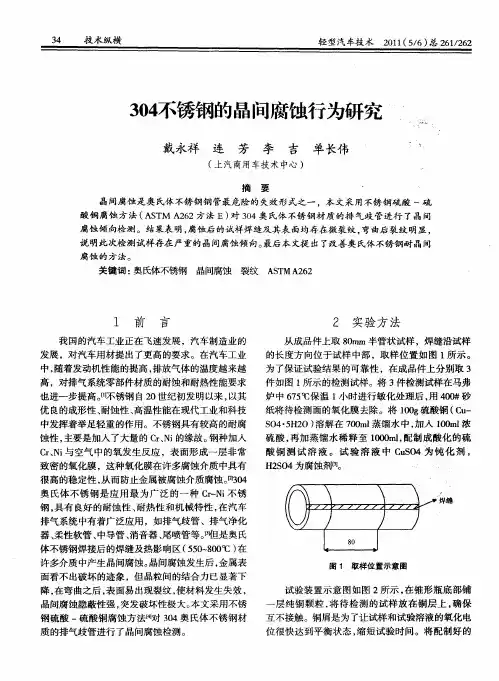
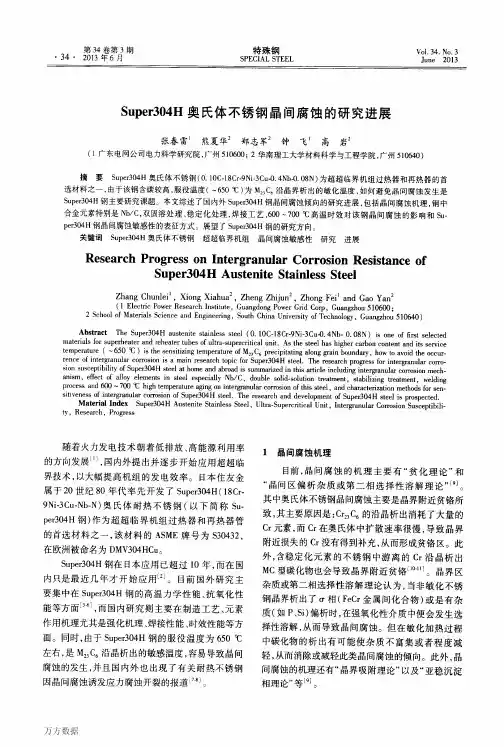

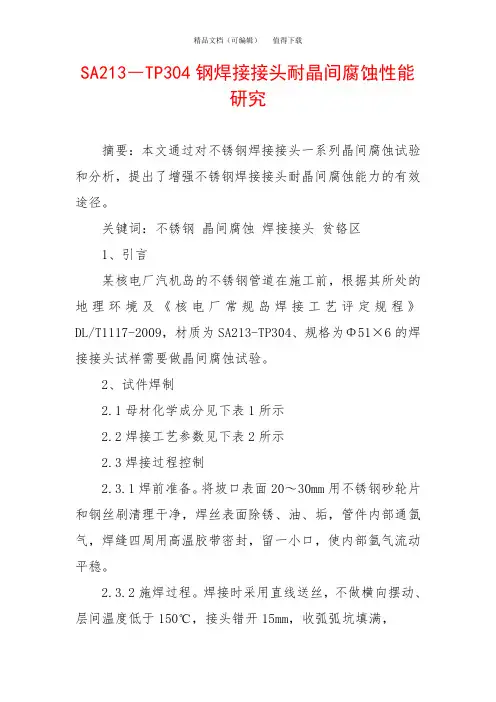
SA213―TP304钢焊接接头耐晶间腐蚀性能研究摘要:本文通过对不锈钢焊接接头一系列晶间腐蚀试验和分析,提出了增强不锈钢焊接接头耐晶间腐蚀能力的有效途径。
关键词:不锈钢晶间腐蚀焊接接头贫铬区1、引言某核电厂汽机岛的不锈钢管道在施工前,根据其所处的地理环境及《核电厂常规岛焊接工艺评定规程》DL/T1117-2009,材质为SA213-TP304、规格为Φ51×6的焊接接头试样需要做晶间腐蚀试验。
2、试件焊制2.1母材化学成分见下表1所示2.2焊接工艺参数见下表2所示2.3焊接过程控制2.3.1焊前准备。
将坡口表面20~30mm用不锈钢砂轮片和钢丝刷清理干净,焊丝表面除锈、油、垢,管件内部通氩气,焊缝四周用高温胶带密封,留一小口,使内部氩气流动平稳。
2.3.2施焊过程。
焊接时采用直线送丝,不做横向摆动、层间温度低于150℃,接头错开15mm,收弧弧坑填满,3、试验结果对试件进行线切割后,试样按照DL/T1117-2009规定进行拉伸、弯曲、微观金相检验,均合格,但两个规格为80×20×4mm的试样,按GB/T4334-2008中方法E进行的晶间腐蚀试验不合格,结果见图1所示。
4、改进工艺后试验之后我们改进了工艺:采用焊丝为ER308L,化学成分及机械性能,层间温度控制在60℃以下,焊接过程管内加铜垫板以加快冷却速度的措施,其他参数不变,试件进行线切割后,根据DL/T1117-2009规定对试样进行拉伸、弯曲、微观金相检验,均合格,从中截取的两个规格为80×20×4mm的试样,按GB/T4334-2008中方法E进行的晶间腐蚀试验合格,见图2所示。
5、试验结果分析5.1化学成分从表1、表3化学成分上看母材SA213-TP304及焊丝ER308L的含碳量均在0.03%以下,奥氏体钢中含碳量为0.02~0.03%时,全部的碳均会溶解在奥氏体中,即使在450℃~850℃加热也不会形成贫铬区,故不会产生晶间腐蚀;另当焊材中含有钛、铌等稳定剂时,钛、铌与碳的亲和力比铬强,这些元素能够与碳形成稳定的碳化物,从而避免在奥氏体晶界产生贫铬,故通常选用超低碳(含碳量在0.03%以下)或含钛、铌等稳定剂时的焊材时不会产生晶间腐蚀。
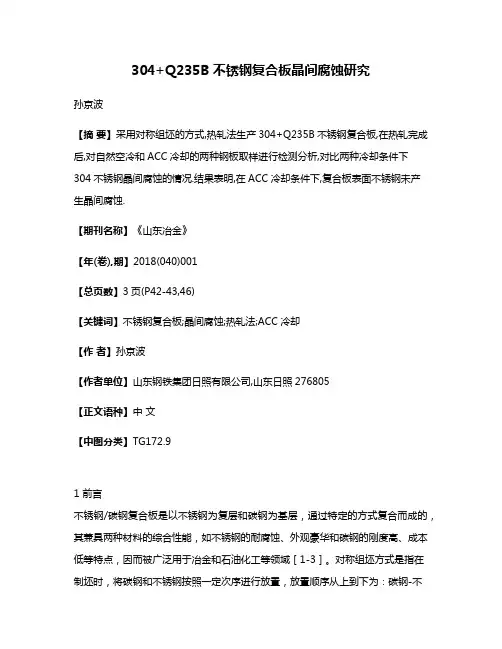
304+Q235B不锈钢复合板晶间腐蚀研究孙京波【摘要】采用对称组坯的方式,热轧法生产304+Q235B不锈钢复合板,在热轧完成后,对自然空冷和ACC冷却的两种钢板取样进行检测分析,对比两种冷却条件下304不锈钢晶间腐蚀的情况.结果表明,在ACC冷却条件下,复合板表面不锈钢未产生晶间腐蚀.【期刊名称】《山东冶金》【年(卷),期】2018(040)001【总页数】3页(P42-43,46)【关键词】不锈钢复合板;晶间腐蚀;热轧法;ACC冷却【作者】孙京波【作者单位】山东钢铁集团日照有限公司,山东日照276805【正文语种】中文【中图分类】TG172.91 前言不锈钢/碳钢复合板是以不锈钢为复层和碳钢为基层,通过特定的方式复合而成的,其兼具两种材料的综合性能,如不锈钢的耐腐蚀、外观豪华和碳钢的刚度高、成本低等特点,因而被广泛用于冶金和石油化工等领域[1-3]。
对称组坯方式是指在制坯时,将碳钢和不锈钢按照一定次序进行放置,放置顺序从上到下为:碳钢-不锈钢-不锈钢-碳钢。
组坯完成后将坯料四周完全封焊,然后对坯料腔体进行抽真空处理。
热轧法生产不锈钢复合板,就是在真空环境下通过高温、高压实现的两种不同金属的冶金结合。
此方法生产不锈钢复合板,在钢板冷却过程中,由于不锈钢在钢板的心部,不锈钢的冷却速度较钢板表面冷却速度慢。
当钢板中间不锈钢的冷却温度和速度达到不锈钢晶间腐蚀区间时,心部的不锈钢就会发生晶间腐蚀,从而大大降低不锈钢复合板的耐腐蚀性。
本研究对304不锈钢晶间腐蚀的影响因素进行分析,对组坯热轧两种方式冷却的复合板取样检测晶间腐蚀情况,以期对生产提供指导。
2 304不锈钢晶间腐蚀影响因素分析1)温度。
当钢板温度<450℃或>850℃时,304不锈钢不会产生晶间腐蚀。
因为温度<450℃时,钢中不会生成Cr23C6;当温度>850℃时,由于扩散能力增强,有足够的Cr扩散至晶界和C结合,不会在晶界形成“贫Cr区”。
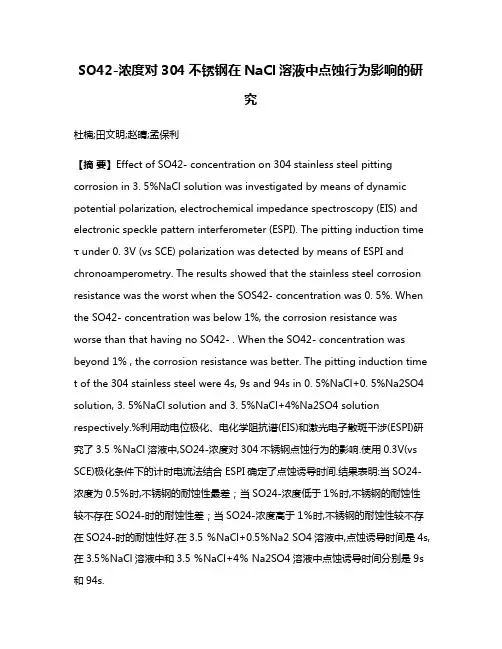
SO42-浓度对304不锈钢在NaCl溶液中点蚀行为影响的研究杜楠;田文明;赵晴;孟保利【摘要】Effect of SO42- concentration on 304 stainless steel pitting corrosion in 3. 5%NaCl solution was investigated by means of dynamic potential polarization, electrochemical impedance spectroscopy (EIS) and electronic speckle pattern interferometer (ESPI). The pitting induction time τ under 0. 3V (vs SCE) polarization was detected by means of ESPI and chronoamperometry. The results showed that the stainless steel corrosion resistance was the worst when the SOS42- concentration was 0. 5%. When the SO42- concentration was below 1%, the corrosion resistance was worse than that having no SO42- . When the SO42- concentration was beyond 1% , the corrosion resistance was better. The pitting induction time t of the 304 stainless steel were 4s, 9s and 94s in 0. 5%NaCl+0. 5%Na2SO4 solution, 3. 5%NaCl solution and 3. 5%NaCl+4%Na2SO4 solution respectively.%利用动电位极化、电化学阻抗谱(EIS)和激光电子散斑干涉(ESPI)研究了3.5 %NaCl溶液中,SO24-浓度对304不锈钢点蚀行为的影响.使用0.3V(vs SCE)极化条件下的计时电流法结合ESPI确定了点蚀诱导时间.结果表明:当SO24-浓度为0.5%时,不锈钢的耐蚀性最差;当SO24-浓度低于1%时,不锈钢的耐蚀性较不存在SO24-时的耐蚀性差;当SO24-浓度高于1%时,不锈钢的耐蚀性较不存在SO24-时的耐蚀性好.在3.5 %NaCl+0.5%Na2 SO4溶液中,点蚀诱导时间是4s,在3.5%NaCl溶液中和3.5 %NaCl+4% Na2SO4溶液中点蚀诱导时间分别是9s 和94s.【期刊名称】《材料工程》【年(卷),期】2012(000)007【总页数】7页(P64-70)【关键词】304不锈钢;点蚀;激光电子散斑干涉技术;硫酸根离子【作者】杜楠;田文明;赵晴;孟保利【作者单位】南昌航空大学轻合金加工科学与技术国防重点学科实验室,南昌330063;南昌航空大学轻合金加工科学与技术国防重点学科实验室,南昌330063;南昌航空大学轻合金加工科学与技术国防重点学科实验室,南昌330063;中航工业西安飞机工业(集团)有限责任公司,西安710089【正文语种】中文【中图分类】TG174304不锈钢是应用最为广泛的一种铬-镍不锈钢,具有优良的不锈耐腐蚀性能和较好的抗晶间腐蚀性能,耐热性、低温强度和力学性能优良,同时具有良好的加工性和可焊性,广泛应用于家庭用品、建材、化学、食品等工业。
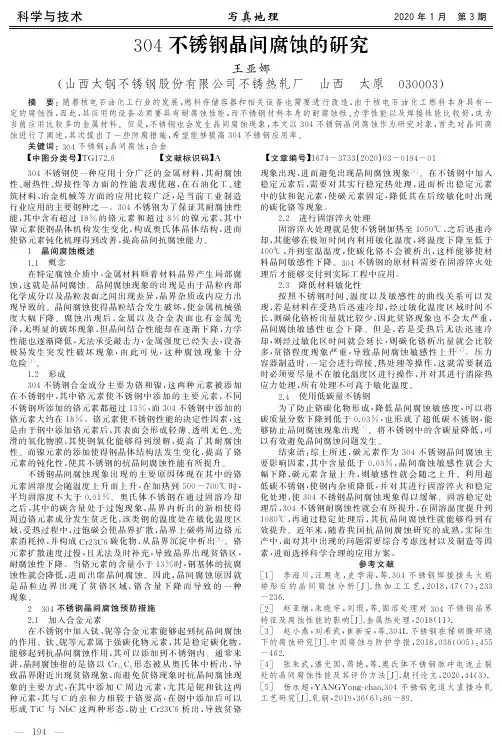
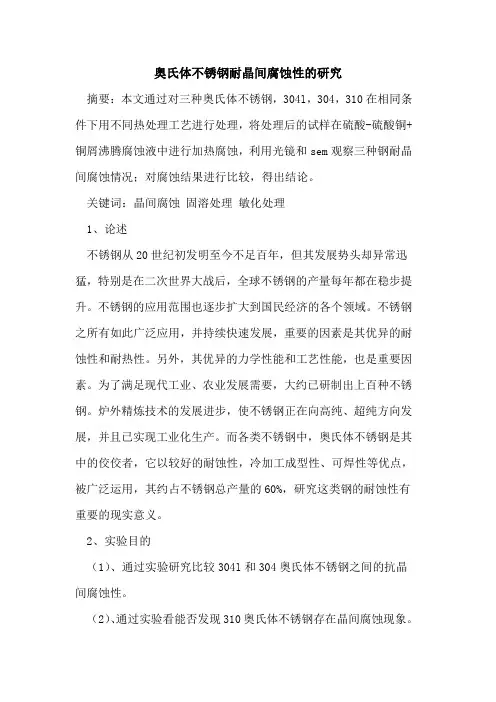
奥氏体不锈钢耐晶间腐蚀性的研究摘要:本文通过对三种奥氏体不锈钢,304l,304,310在相同条件下用不同热处理工艺进行处理,将处理后的试样在硫酸-硫酸铜+铜屑沸腾腐蚀液中进行加热腐蚀,利用光镜和sem观察三种钢耐晶间腐蚀情况;对腐蚀结果进行比较,得出结论。
关键词:晶间腐蚀固溶处理敏化处理1、论述不锈钢从20世纪初发明至今不足百年,但其发展势头却异常迅猛,特别是在二次世界大战后,全球不锈钢的产量每年都在稳步提升。
不锈钢的应用范围也逐步扩大到国民经济的各个领域。
不锈钢之所有如此广泛应用,并持续快速发展,重要的因素是其优异的耐蚀性和耐热性。
另外,其优异的力学性能和工艺性能,也是重要因素。
为了满足现代工业、农业发展需要,大约已研制出上百种不锈钢。
炉外精炼技术的发展进步,使不锈钢正在向高纯、超纯方向发展,并且已实现工业化生产。
而各类不锈钢中,奥氏体不锈钢是其中的佼佼者,它以较好的耐蚀性,冷加工成型性、可焊性等优点,被广泛运用,其约占不锈钢总产量的60%,研究这类钢的耐蚀性有重要的现实意义。
2、实验目的(1)、通过实验研究比较304l和304奥氏体不锈钢之间的抗晶间腐蚀性。
(2)、通过实验看能否发现310奥氏体不锈钢存在晶间腐蚀现象。
2、实验材料3、实验设备箱式热处理炉,光学显微镜,扫描电子显微镜,直通式光谱分析仪等。
4、实验方法及过程4.1 固溶处理(1)工艺:加热温度,t=1050±10?c;保温时间,t=150min;冷却方式,常温水冷却;(2)目的:将不锈钢加热到单一奥氏体区,得到成分均匀的单一奥氏体,快冷,使高温成分均匀过饱和固溶体组织保持到室温,此时钢具有最高的耐蚀性。
4.2敏化处理(1)工艺:加热温度,t=650±10?c;保温时间,t=16h;冷却方式,空冷;(2)目的:奥氏体不锈钢450-850?c进行长时间保温停留,将在晶界处充分析出cr23c6等碳化物或σ相,从而造成晶界周围出现贫cr区,或让s、p、si等杂质元素在晶界出偏聚,为后续硫酸-硫酸铜+铜屑晶间腐蚀实验创造条件,以便晶界发生腐蚀。
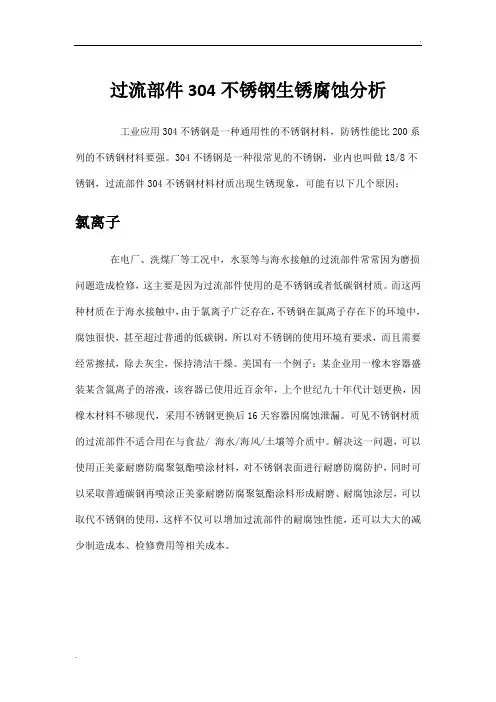
过流部件304不锈钢生锈腐蚀分析工业应用304不锈钢是一种通用性的不锈钢材料,防锈性能比200系列的不锈钢材料要强。
304不锈钢是一种很常见的不锈钢,业内也叫做18/8不锈钢,过流部件304不锈钢材料材质出现生锈现象,可能有以下几个原因:氯离子在电厂、洗煤厂等工况中,水泵等与海水接触的过流部件常常因为磨损问题造成检修,这主要是因为过流部件使用的是不锈钢或者低碳钢材质。
而这两种材质在于海水接触中,由于氯离子广泛存在,不锈钢在氯离子存在下的环境中,腐蚀很快,甚至超过普通的低碳钢。
所以对不锈钢的使用环境有要求,而且需要经常擦拭,除去灰尘,保持清洁干燥。
美国有一个例子:某企业用一橡木容器盛装某含氯离子的溶液,该容器已使用近百余年,上个世纪九十年代计划更换,因橡木材料不够现代,采用不锈钢更换后16天容器因腐蚀泄漏。
可见不锈钢材质的过流部件不适合用在与食盐/ 海水/海风/土壤等介质中。
解决这一问题,可以使用正美豪耐磨防腐聚氨酯喷涂材料,对不锈钢表面进行耐磨防腐防护,同时可以采取普通碳钢再喷涂正美豪耐磨防腐聚氨酯涂料形成耐磨、耐腐蚀涂层,可以取代不锈钢的使用,这样不仅可以增加过流部件的耐腐蚀性能,还可以大大的减少制造成本、检修费用等相关成本。
固溶处理合金元素没有溶入基体,致使基体组织合金含量低,抗蚀性能差。
这也是不锈钢材料容易被腐蚀的原因之一。
这是不锈钢制作工艺中存在的问题,同时也是无法避免的问题,如果想要解决这一问题,可能要耗费大量的成本、工艺。
晶间腐蚀这种不含钛和铌的材料有晶间腐蚀的倾向。
加入钛和铌,再配以稳定处理,可以减少晶间腐蚀。
在空气中或化学腐蚀介质中能够抵抗腐蚀的一种高合金钢,不锈钢是具有美观的表面和耐腐蚀性能,不必经过镀色等表面处理,而发挥不锈钢所固有的表面性能,使用于多方面的钢铁的一种,通常称为不锈钢。
代表性能的有13铬钢,18-8铬镍钢等高合金钢。
从金相学角度分析,因为不锈钢含有铬而使表面形成很薄的铬膜,这个膜隔离开与钢内侵入的氧气起耐腐蚀的作用。


外文文献304不锈钢晶间腐蚀研究晶间腐蚀在石油石化行业的危害及防护帕德·马纳班每一个石油化工企业年度改革、更新和超过6/809的维修费用,都是由于腐蚀和废弃设备、管道及金属非金属结构更新维护造成的,腐蚀易引起恶性破坏事故,不仅会带来巨大的经济损失,而且经常会引起火灾和爆炸、伤害和灾难性的环境污染等的罪恶,并导致严重的社会后果。
腐蚀损坏,必须尽力设法避免。
因为消除腐蚀是不可能的,成功的方法是控制腐蚀,或进入是为了防止腐蚀。
因此,这些腐蚀问题已引起人们的关注来控制。
本文主要针对表面产生晶间腐蚀的危害的石油工业,并介绍了如何防止和减缓腐蚀采取的措施。
1晶间腐蚀的定义晶间腐蚀是局部腐蚀的一种,是沿着金属晶粒间的分界面向内部扩展的沿着或紧挨着金属的晶粒边界发生的腐蚀。
晶间腐蚀(Intergranular corrosion),又叫晶界腐蚀。
现在对晶间腐蚀的科技名词定义如下:沿着或挨着晶粒边界发生的腐蚀。
:海洋工程(1级主题);船舶腐蚀与防护(要求等级2的主题)。
由于金属部件中这一媒介溶解率远远高于粮食本体的速度从局部腐蚀溶解。
是金属强度、塑性和韧性大大降低危险的大量的腐蚀类型。
所属主题:电力(一级学科);核能(要求等级2的话题)。
沿着或挨着金属颗粒边界腐蚀。
所属属主题:机械工程(1级主题);腐蚀与防护(二级学科);腐蚀类型(三级学科)。
晶间腐蚀由微电池作用而引起局部破坏,这种局部破坏是从表面开始,沿晶界向内发展,直至整个金属由于晶界破坏而完全丧失强度,这是一种危害很大的局部腐蚀。
2晶间腐蚀发生的条件金属及其结构在其所处的环境中,许多因素往往和环境化学因素及电化学因素一起,参与和影响金属腐蚀过程。
除化学因素及金属的冶金因素(成分、金相组织和结构等)外,影响金属腐蚀的环境因素还包括:应力、振动、冲刷、摩擦与磨损等力学、机械学因素;生物学因素等。
这些因素与化学因素对腐蚀的影响,往往不是各个因素单独作用时所发生影响的简单加和,在多数情况下起着彼此相张的作用,因而,常常使腐蚀加速,造成更大的破坏性后果。
《资料腐蚀与防护》结课作业之巴公井开创作时间:二O二一年七月二十九日304奥氏体不锈钢的晶间腐蚀陈述班级:成型1303班姓名:赵旭男学号:20132336304奥氏体不锈钢是指在常温下具有奥氏体组织的不锈钢,钢中含Cr约18%、含Ni约8%、C约0.1%时,具有稳定的奥氏体组织。
它是一种很罕见的不锈钢资料,业内也叫做18/8不锈钢。
奥氏体不锈钢无磁性而且具有高韧性和塑性,但强度较低,不成能通过相变使之强化,仅能通过冷加工进行强化,具有良好的易切削性。
304奥氏体不锈钢的防锈性能比200系列的不锈钢资料要强,密度为7.93 g/。
它在耐高温方面也比较好,最高可承受1000℃~1200℃。
它具有优良的耐腐蚀性能和较好的抗晶间腐蚀性能,加工性能好且韧性高,被广泛应用。
适用于食品的加工储存、家庭用品、汽车配件、医疗器具、化学建材,农业船舶部件等。
304奥氏体不锈钢中最为重要的元素是Ni和Cr,但是又不但限于这两种元素。
对于304奥氏体不锈钢来说,其成分中的Ni元素十分重要,直接决定着它的抗腐蚀能力。
它正是因为有足够含量的铬,其呵护性氧化膜是自愈性的。
当其薄膜破坏时,重新形成新的呵护性氧化薄膜。
致使它能进行机械加工也不失去抗氧化性能。
然而当金属含铬量不敷或某些原因造成不锈钢晶界贫铬,就不克不及形成呵护性氧化膜。
这就说明不锈钢之所以不锈,关键在于要有足够的铬和足够的氧。
此外,Ni与Cr配合,在不锈钢中发挥着重要作用。
Ni在不锈钢中的主要作用在于其改变了钢的晶体结构,形成奥氏体晶体结构,从而改善和加强Cr 的钝化机理,其抗晶间腐蚀能力得到提高。
表1C Si Mn P S Cr Ni N 304347321304、347、321钢的化学成分表格1(%)奥氏体不锈钢在许多介质环境中容易发生晶间腐蚀、点腐蚀、缝隙腐蚀、应力腐蚀、腐蚀疲劳等腐蚀类型。
在其中加入分歧元素可得到分歧特性,加Mo改善点蚀和耐缝隙腐蚀,降低C含量或加入Ti和Nb可减少晶间腐蚀倾向,加Ni和Cr可改善高温抗氧化性和强度,加Ni改善抗应力腐蚀性能。
304不锈钢晶间腐蚀及其防护技术的研究的开题报告题目:304不锈钢晶间腐蚀及其防护技术的研究背景及意义:304不锈钢是一种常用的不锈钢材料,广泛应用于化工、石油、制药等领域。
然而在某些环境下,304不锈钢存在着晶间腐蚀的问题,即在晶界处形成的腐蚀痕迹,会导致材料的机械性能下降、甚至断裂,严重影响到设备的安全运行。
因此,对于304不锈钢晶间腐蚀问题的研究具有重要的实际意义。
通过研究晶间腐蚀的机理,探索有效的防腐措施,可为工业生产中的不锈钢材料应用提供科学的指导和技术支持。
研究内容:本研究旨在探究304不锈钢晶间腐蚀的机理,研究常见的防腐措施及其效果,并对新的防腐技术进行探索和研究。
具体包括以下内容:1. 304不锈钢晶间腐蚀的机理分析:通过实验和理论推导,深入探究晶间腐蚀的机理,认识不同环境因素对晶间腐蚀的影响。
2. 常见的防腐措施及其效果分析:分析目前工业生产中常用的防腐措施,如利用缓蚀剂、防锈涂料等,探究其防腐效果、使用寿命等问题。
3. 新的防腐技术研究:通过文献调研和实验研究,探索新的防腐技术,如利用纳米材料、化学法等等,对于防腐材料的研究和开发提供新的思路和方向。
研究方法:1. 实验研究:采用金相显微镜、扫描电镜、能谱分析等技术手段,对不锈钢材料进行形态和成分的分析和表征。
2. 模拟实验:通过模拟实验方法,研究不同环境条件下晶间腐蚀的变化,并对不同的防腐措施进行比较和评价。
3. 数值模拟:使用有限元模拟等方法,对不锈钢材料进行力学性能分析和晶间腐蚀条件下的材料断裂模拟等研究。
预期成果:1. 探究304不锈钢晶间腐蚀的机理及主要影响因素。
2. 分析不同防腐措施及其效果,为工业生产中的材料选择提供科学的指导和技术支持。
3. 发现新的防腐技术,为工业生产中的材料研发提供思路和方向。
4. 提出针对304不锈钢晶间腐蚀问题的可行的防腐方案,为工业生产提供保障。
利用SECM技术研究304不锈钢的点蚀行为张明明;孟君;黄晓义;路遥【期刊名称】《腐蚀与防护》【年(卷),期】2012(033)006【摘要】Pitting corrosion process of 304 stainless steel in NaCl solution was investigated using scanning electrochemical microscopy (SECM),combined with the measurements of electrical conductivity and cyclic voltammetry.The results showed that there were meta-stable electrically active sites on the surface of stainless steel in the initial pitting process.In the formation process of pits,some initiated meta-stable electrically active sites might disappear,some might propagate and finally become stable pits,while new ones might be induced.Thegeneration,disappearance of meta-stable electrically active sites and formation of pits occurred simultaneously.The electrical conductivity of NaCl solution was related with the concentration of Fe2+ in the solution.The higher the concentration of Fe2+ in NaCl solution,the greater the steady-state current detected by superfine electrode probe.%采用扫描电化学显微镜(SECM)技术,结合电导率和循环伏安测试,研究了304不锈钢在NaCl溶液中的点蚀行为。
创作编号:GB8878185555334563BT9125XW创作者:凤呜大王*《材料腐蚀与防护》结课作业304奥氏体不锈钢的晶间腐蚀报告班级:成型1303班姓名:赵旭男学号:20132336304奥氏体不锈钢是指在常温下具有奥氏体组织的不锈钢,钢中含Cr 约18%、含Ni约8%、C约0.1%时,具有稳定的奥氏体组织。
它是一种很常见的不锈钢材料,业内也叫做18/8不锈钢。
奥氏体不锈钢无磁性而且具有高韧性和塑性,但强度较低,不可能通过相变使之强化,仅能通过冷加工进行强化,具有良好的易切削性。
304奥氏体不锈钢的防锈性能比200系列的不锈钢材料要强,密度为7.93 g/。
它在耐高温方面也比较好,最高可承受1000℃~1200℃。
它具有优良的耐腐蚀性能和较好的抗晶间腐蚀性能,加工性能好且韧性高,被广泛应用。
适用于食品的加工储存、家庭用品、汽车配件、医疗器具、化学建材,农业船舶部件等。
304奥氏体不锈钢中最为重要的元素是Ni和Cr,但是又不仅限于这两种元素。
对于304奥氏体不锈钢来说,其成分中的Ni元素十分重要,直接决定着它的抗腐蚀能力。
它正是因为有足够含量的铬,其保护性氧化膜是自愈性的。
当其薄膜破坏时,重新形成新的保护性氧化薄膜。
致使它能进行机械加工也不失去抗氧化性能。
然而当金属含铬量不够或某些原因造成不锈钢晶界贫铬,就不能形成保护性氧化膜。
这就说明不锈钢之所以不锈,关键在于要有足够的铬和足够的氧。
此外,Ni与Cr配合,在不锈钢中发挥着重要作用。
Ni在不锈钢中的主要作用在于其改变了钢的晶体结构,形成奥氏体晶体结构,从而改善和加强Cr 的钝化机理,其抗晶间腐蚀能力得到提高。
表1C Si Mn P S Cr Ni N304 0.010 ≤1.0 ≤2.0 ≤0.045 ≤0.03 18.0/20.0 8.00/10.0 ≤0.10 347 ≤0.08 ≤1.0 ≤2.0 ≤0.045 ≤0.03 17.0/19.0 9.00/13.0 ≤0.10 321 ≤0.08 ≤1.0 ≤2.0 ≤0.045 ≤0.03 17.0/19.0 9.00/12.0304、347、321钢的化学成分表格1(%)奥氏体不锈钢在许多介质环境中容易发生晶间腐蚀、点腐蚀、缝隙腐蚀、应力腐蚀、腐蚀疲劳等腐蚀类型。
400℃时效对304不锈钢晶间敏化行为的影响晋圣发【摘要】The 400 ℃aged 304 stainless steels were characterized for their degree of sensitization ( DOS) by double-loop (DL) electrochemical potentiokinetic reactivation (EPR) method.Then the chromium depletion zones of these tested specimens were observed by metallographic microscope .The results showed that the degree of sensitization of solution 304 after solution treatment did not increase under 400 ℃×10 haging ,while the degree of sensitization of 650℃sensitized 304 increased ob viously under the same 400℃×10 h aging.Thus solution treatment is very important for 304 stainless steel .Hot working process should be controlled strictly to prevent increasing of DOS and occurring of intergranular corrosion ,espe-cially for those which have not carried on solution treatment .%采用双环电化学动电位再活化法( EPR)对400℃时效处理后的304不锈钢试样进行晶间腐蚀试验,并采用金相法观察试验后试样贫铬区的形态特征。
华东理工大学硕士学位论文敏化型304不锈钢在三点弯曲载荷作用下应力腐蚀特性的研究A Study of Stress Corrosion Behavior of Sensitized 304 Stainless Steel under Three PointBending作者声明我郑重声明:本人恪守学术道德,崇尚严谨学风。
所呈交的学位论文,是本人在导师的指导下,独立进行研究工作所取得的结果。
除文中明确注明和引用的内容外,本论文不包含任何他人已经发表或撰写过的内容。
论文为本人亲自撰写,并对所写内容负责。
论文作者签名:年月日华东理工大学硕士学位论文第I页摘要应力腐蚀是304不锈钢最常见的腐蚀失效形式之一,它是应力和腐蚀介质共同作用下的延迟破裂,具有脆性断裂的特征,往往对设备和人员造成很大危害。
本文通过对敏化304不锈钢进行三点弯实验、SSRT实验、显微组织观察、EDS、XRD、SEM等测试技术对奥氏体不锈钢的应力腐蚀机理进行了较全面的研究。
提出用非标准小试样三点弯实验来评价材料的应力腐蚀行为,为服役设备不影响正常工作下的半无损检验提供了科学依据。
本文的主要工作和取得的主要研究进展如下:(1)从金相分析得知在650℃敏化,随时间的延长材料的晶界沟槽组织越来越明显,说明材料在敏化作用下抗腐蚀性能下降;(2)在650℃对304不锈钢进行敏化处理从0-100h随着时间的延长腐蚀电位不断下降腐蚀电流逐渐增大,敏化200h的304不锈钢的腐蚀电位与100h相比有所提高,而腐蚀电流下降;从极化曲线和腐蚀电位、腐蚀电流曲线可看出,在0-100h随着时间的延长材料抗腐蚀性逐渐下降,敏化100-200h时抗腐蚀性有所提高;(3)随着敏化时间的延长304不锈钢的延伸率在不断下降,抗拉力却在不断提高;(4)在未加载荷和1kg载荷下(试样下表面中间最大应力85MPa),随着敏化时间从0至100h的延长腐蚀速率逐渐增大,敏化时间从100h-200h时腐蚀速率出现下降趋势;在2kg载荷(试样下表面中间最大应力170MPa)作用下,腐蚀后铬含量的损失量随敏化时间的延长而增大,并且在试样时间下表面出现鼻尖现象即应力与铬的损失量成正趋势;(5)三点弯试验下试样加载点的挠度急剧增大的转变时间随着敏化时间的延长而增大,而且都有一段平稳的过渡期;(6)在SSRT实验中观察到试样产生点蚀坑,由此可以推论:敏化型不锈钢由于点蚀的作用产生局部应力集中,最后在拉应力作用下导致开裂。
晶间腐蚀在石油石化行业的危害及防护帕德·马纳班每一个石油化工企业年度改革、更新和超过6/809的维修费用,都是由于腐蚀和废弃设备、管道及金属非金属结构更新维护造成的,腐蚀易引起恶性破坏事故,不仅会带来巨大的经济损失,而且经常会引起火灾和爆炸、伤害和灾难性的环境污染等的罪恶,并导致严重的社会后果。
腐蚀损坏,必须尽力设法避免。
因为消除腐蚀是不可能的,成功的方法是控制腐蚀,或进入是为了防止腐蚀。
因此,这些腐蚀问题已引起人们的关注来控制。
本文主要针对表面产生晶间腐蚀的危害的石油工业,并介绍了如何防止和减缓腐蚀采取的措施。
1晶间腐蚀的定义晶间腐蚀是局部腐蚀的一种,是沿着金属晶粒间的分界面向内部扩展的沿着或紧挨着金属的晶粒边界发生的腐蚀。
晶间腐蚀(Intergranular corrosion),又叫晶界腐蚀。
现在对晶间腐蚀的科技名词定义如下:沿着或挨着晶粒边界发生的腐蚀。
:海洋工程(1级主题);船舶腐蚀与防护(要求等级2的主题)。
由于金属部件中这一媒介溶解率远远高于粮食本体的速度从局部腐蚀溶解。
是金属强度、塑性和韧性大大降低危险的大量的腐蚀类型。
所属主题:电力(一级学科);核能(要求等级2的话题)。
沿着或挨着金属颗粒边界腐蚀。
所属属主题:机械工程(1级主题);腐蚀与防护(二级学科);腐蚀类型(三级学科)。
晶间腐蚀由微电池作用而引起局部破坏,这种局部破坏是从表面开始,沿晶界向内发展,直至整个金属由于晶界破坏而完全丧失强度,这是一种危害很大的局部腐蚀。
2晶间腐蚀发生的条件金属及其结构在其所处的环境中,许多因素往往和环境化学因素及电化学因素一起,参与和影响金属腐蚀过程。
除化学因素及金属的冶金因素(成分、金相组织和结构等)外,影响金属腐蚀的环境因素还包括:应力、振动、冲刷、摩擦与磨损等力学、机械学因素;生物学因素等。
这些因素与化学因素对腐蚀的影响,往往不是各个因素单独作用时所发生影响的简单加和,在多数情况下起着彼此相张的作用,因而,常常使腐蚀加速,造成更大的破坏性后果。
而晶间腐蚀的发生因素主要有内因和外因,如下:⑴内因:即金属或合金本身晶粒与晶界化学成分差异、晶界结构、元素的固溶特点、沉淀析出过程、固态扩散等金属学问题,导致电化学不均匀性,使金属具有品间腐蚀倾向。
⑵外因:在腐蚀介质中能显示晶粒与晶界的电化学不均匀性。
3晶间腐蚀的机理20世纪30年代以来,对晶间腐蚀进行了大量研究,所提出的贫化理论,特别是对奥氏体不锈钢的贫铬理论已得到证实,并将贫化理论应用到铝铜合金的贫铜及镍钼合金的贫钼等方面。
前者在晶界上析出了CuAl 2,后者在晶界上析出了Mo 2C 。
⑴ 贫铬理论不锈钢具有耐腐蚀能力的必要条件是铬的质量分数必须大于10~12%。
当温度升高时,碳在不锈钢晶粒内部的扩散速度大于铬的扩散速度。
因为室温时碳在奥氏体中的溶解度很小,约为0.02%~0.03%,而一般奥氏体不锈钢中 的含碳量均超过此值,故多余的碳就不断地向奥氏体晶粒边界扩散,并和铬化合,在晶间形成碳化铬的化合物,如(CrFe )23C6等。
数据表明,铬沿晶界扩 散的活化能力162~252KJ/mol ,而铬由晶粒内扩散活化能约540KJ/mol ,即:铬由晶粒内扩散速度比铬沿晶界扩散速度小,内部的铬来不及向 晶界扩散,所以在晶间所形成的碳化铬所需的铬主要不是来自奥氏体晶粒内部,而是来自晶界附近,结果就使晶界附近的含铬量大为减少,当晶界的铬的质量分数低到小于12%时,就形成所谓的“贫铬区”,在腐蚀介质作用下,贫铬区就会失去耐腐蚀能力,而产生晶间腐蚀。
使不锈钢产生晶间腐蚀倾向的热处理叫做敏化热处理。
奥氏体不锈钢的敏化热处理范围为450︒C—850︒C。
当奥氏体不锈钢在这个温度范围较长时间加热(如焊接)或缓慢冷却,就产生了晶间腐蚀敏感性。
铁素体不锈钢的敏化温度在900︒C以上,而在700-800︒C 退火可以消除晶间腐蚀倾向。
敏化处理对不锈钢晶间腐蚀的影响,与加热温度、加热时间都有关系。
将处理后的试样进行试验,把结果表示在以加热温度(T)和加热时间(T)为纵、横坐标的图上,发生晶间腐蚀的区域的边界称为TTS曲线(S表示晶间腐蚀敏感性)。
⑵晶界杂质选择溶解理论当晶界上析出了σ相(FeCr金属间化合物),或是有杂质(如磷、硅)偏析,在强氧化性介质中便会发生选择性溶解,从而造成晶间腐蚀。
上述两种解释晶间腐蚀机理的理论各自适用于一定合金的组织状态和一定的介质,不是互相排斥而是互相补充的。
但应该看到,最常见的晶间腐蚀多数是在弱氧化性或氧化性性介质中发生的,因而对绝大多数的腐蚀实例都可以用贫化理论来解释。
对不锈钢尤其如此。
引起常用奥氏体不锈钢晶间腐蚀的介质,主要有两类。
一类是氧化性或弱氧化性介质,一类是强氧化性介质。
前者是充气的海水,MgCl2溶液等,后者是浓HNO3和Na2Cr2O7溶液等,以前者较为普通,腐蚀亦较为严重。
4晶间腐蚀的影响因素⑴加热温度和加热时间。
⑵高温或回火时间长,可使Cr在晶粒和晶界上浓度平均化,消除晶间腐蚀敏感性。
⑶最短回火时间:tmin>1h。
⑷合金成分的影响。
①碳:奥氏体不锈钢中碳量愈高.晶间腐蚀倾向愈严重。
②铬、钼:含量增高,可降低C的活度,有利于减弱晶间腐蚀倾向。
③钛和铌:Ti和Nb与C亲合力大于Cr与C的亲合力,高温时于易形成稳定的碳化物TiC及NbC,从而大大降低了钢中的固溶碳量,使铬碳化物难以析出。
从而减弱晶间腐蚀。
④镍:增加敏感性。
5晶间腐蚀在石油石化行业的危害及防护⑴晶间腐蚀在石油石化行业的危害晶间腐蚀发生后,金属和合金虽然表面仍保持一定的金属光泽,也看不出被破坏的迹象,但晶粒间的结合力已显著减弱,强度下降,因此设备和构件容易遭到破坏。
晶间腐蚀隐蔽性强,突发性破坏几率大,因此有严重的危害性。
不锈耐酸钢、镍基耐蚀合金、铝合金等金属材料都有可能产生晶间腐蚀;尤其在焊接时,焊缝附近的热影响区更容易发生晶间腐蚀。
国内外很多石油石化的被焊接件(管道、压力容器)的热影响区都因为晶间腐蚀发生问题,刚开始检查不出问题,突发性很强,往往让人准备不足,造成很大的问题。
⑵防止或减缓晶间腐蚀的措施①改变介质的腐蚀性。
②调整焊缝的化学成份,加入稳定化元素减少形成碳化铬的可能性,如在不锈钢中添加钛、铌等强碳化物形成元素,形成碳化钛和碳化铌,以减少晶界贫铬现象。
③减少焊缝中的含碳量,可以减少和避免形成铬的碳化物,从而降低形成晶界腐蚀的倾向,含碳量在0.04%以下,称为“超低碳”不锈钢,就可以避免铬的碳化物生成。
④采用适当的工艺措施:a.尽量避免金属或合金在不适宜的温度受热。
b.选择合适的热处理工艺,如铝合金过时效处理;c.在确定焊接工艺,铝合金胶接及铣切工艺,回避容易产生晶间腐蚀的温度下处理。
6结论本文只是简单的介绍了晶间腐蚀的危害及防护措施,可见晶间腐蚀的危害之大,其实金属腐蚀在石油石化行业的危害是巨大的,国家每年在这方面的损失很大,因此腐蚀科学与保护技术的研究与发展,消除在苛刻的强化操作条件下设备腐蚀引发的恶性事故的隐患,将直接影响到国民经济与国防建设的安全保障和经济效益具有极其重要的意义Intergranular corrosion in petroleum and petrochemicalindustry, harm and protectionPard ManabhanEvery oil chemical enterprise annual overhaul, updating, and over 6/809 of the cost of maintenance, with due to corrosion and scrap in equipment, pipeline and metal (non-metallic) structure update maintenance, the loss caused by corrosion is very considerable. And corrosion easy cause of the outbreak of malignant destruction accidents, will not only bring huge economic losses, and often can cause fires and explosions, injury and disastrous environmental pollution and so on of evil, and cause serious social consequences. The corrosion damage, must try our best to try to avoid. Because eliminate corrosion is impossible, successful way is to control corrosion, or into is to prevent corrosion. Therefore, the corrosion problems have been caused people to control the concern. This article mainly aims at the intergranular corrosion in the harm of the oil industry, are introduced, and how to prevent and slow to take measures.1.The definition of Intergranular corrosionoftheIntergranular corrosion is a kind of local corrosion, is along the boundary between metal grain for internal extended along or next to the metal grain boundaries of corrosion occurred. Intergranular corrosion (Intergranular corrosion), also called from corrosion. Now intergranular corrosion of the science and technology noun defined as follows: Along the or next to the corrosion of the grain boundaries. Subordinate subject: Marine engineering (grade 1 subject); Ship corrosion and protection (level 2 subject).Because of the metal components in the medium from dissolving rate is much higher than the rate of grain ontology dissolved from the local corrosion. Is the metal strength, plasticity and toughness greatly reduce the dangers of a lot of corrosion types. Subordinate subject: electric power (level 1 subject); Nuclear power (level 2 subject).Along the or next to metal grain boundaries corrosion. Subordinate subject: mechanicalengineering (grade 1 subject); Corrosion and pro-tection (secondary discipline); Corrosion types (level 3 subject).Intergranular corrosion by micro cell function and cause local damage,the local damage from surface began, and along the development of grain boundaries to, until the whole metal destroyed completely lost due to the effects of strength, which is a great harm local corrosion.2 The conditions of intergranular corrosion occurrenceMetal and its structure in its surroundings, many factors often and environment factors and electrochemical chemical factors together, par-ticipation and affect metal corrosion process. In addition to chemical factors and metal metallurgy factors (composition, microstructure and structure, etc) outside, the influence of the metal corrosion environment factors include: stress, vibration, flushing, friction and wear of mechanics, mechanical factors; Biological factors. These factors and chemical factors on the influence of the corrosion, more often than not, each factor alone when the impact of what happened role with simple and, in most cases plays a role in each other, therefore, often make accelerated corrosion, causing even greater destructive consequences.And the occurrence of intergranular corrosion factors are internal and external causes, as follows:(1) the internal cause: namely metal or alloy itself with chemical composition differences from grain, grain boundaries structure, elements of solid solution characteristics, precipitation separation process, solid-state diffusion of metal science etc.it problems, which uniformity electrochemical, the metal is between product corrosion tendency.(2) the external cause: in the corrosive medium can display grain boundaries and electrochemical not uniformityThe mechanism of intergranular corrosionSince the 1930 s, intergranular corrosion of the studies, proposed the theory of dilution, especially for austenitic stainless steel poor ch-romium theory has confirmed, and it will be applied to the copper alloy aluminum theoryof copper and nickel molybdenum alloy poverty poverty molybdenum, etc. The former in the CuAl2 separation on grain boundaries, the latter in the Mo2C separation on grain boundary.(1) the poor chromium theoryStainless steel to provide corrosion ability is the necessary condition of chromium quality score must be more than 10 ~ 12%. When the temperature rises, the carbon in the spread of stainless steel grain internal speed is greater than the spread of chromium speed. Because when the room temperature carbon austenitic solubility is very small, about 0.02% ~ 0.03%, and the general austenitic stainless steel in more than the value of all the carbon content, so spare the carbon continually to austenitic grain boundary diffusion, and and chromium combined, it is formed between chrome carbide crystal compounds such as (CrFe) and C6, etc. The data show that the expansion of grain boundaries chromium scattered activation 162 ~ 252 KJ/mol, and chromium by grain spread within about 540 activation energy KJ/mol, namely: chrome spread within the grain size faster than chrome diffusion speed along the effects of small, internal chromium too late to spread grain boundary, so the wafer by the formation of the chrome carbide between the chrome mainly comes not from austenite grain internal, but from near the grain boundary, the consequence is that near the grain boundary containing cr quantity is greatly reduced and the boundaries of chromium when quality score low to less than 12%, the formation of the so-called "poor chromium area", and in the corrosive medium function, poor chromium area will lose the ability to corrosion resistance, and produce intergranular corrosion.Make stainless steel intergranular corrosion tend to produce the heat treatment called sensitization heat treatment. Austenitic stainless steel sensitization heat treatment range for 450 ° C-850 ° C. When austenitic stainless steel in the temperature range longer heating (such as welding) or slow cooling, produce the intergranular corrosion sensitivity. Ferritic stainless steel sensitization temperature in the 900 ° C above, and in the 700-800 ° C annealing intergranular corrosion can eliminate tendency.Sensitization treatment on the influence of intergranular corrosion stainless steel, and heating temperature, heating time have relations. Will process after the specimen test, results in the said heating temperature (T) and heating time (T) for vertical and the abscissa denotes the chart, intergranular corrosion occurred the edge of the area called TTS curve (S intergranular corrosion said sensitivity).TTS curve made it clear that be test sensitization of stainless steel processing temperature and time range (as shown in figure 3).(2) the effects of impurities choose dissolve theoryWhen on the phase separation from σ (FeCr intermetallic), or impurity (such as p, silicon) segregation, in strong oxidizing media will happen dissolution, causing the intergranular corrosion.The above two kinds of intergranular corrosion mechanism of explain theory apply their own in a certain state and the organization of the alloy certain medium, not mutually exclusive but complement each other. But should see, the most common intergranular corrosion most are in weak oxidizing or oxidizing sex medium happen, and thus for most of the corrosion examples can use dilution theory to explain. Especially for stainless steel.Cause commonly used austenitic stainless steel intergranular corrosion medium, basically has two kinds. One kind is oxidizing or weak oxidizing medium, one kind is strong oxidizing medium. The former is filling of the sea water, MgCl2 solution, the latter is strong HNO3 and Na2Cr2O7 solution, so as to the former are normal, have a serious corrosion.Four, the influence factors of intergranular corrosion(1) the heating temperature and heating time.(2) high temperature or tempering time is long, can make the grain and the grain boundary Cr average concentration, eliminate intergranular corrosion sensitivity.(3) the shortest tempering time: tmin > 1 h.(4) the effect of alloy composition.(1) carbon: austenitic stainless steel in the higher carbon. Intergranular corrosion the more serious tendency.(2) the chromium, molybdenum: content increased, can reduce C activity, be helpful for intergranular corrosion weakened tendency.(3) titanium and niobium: Ti and Nb and C affinity with C than Cr affinity, high temperature in easy to form stable carbon TiC and NbC, which greatly reduced the solid solution carbon steel, make chrome carbide difficult to exhalation. Thus intergranular corrosion weakened.(4) the nickel: increase sensitivity.Intergranular corrosion in five, petroleum and petrochemical industry, harm and protection(1) the intergranular corrosion in the dangers of petroleum and petrochemical industryAccording to the developed countries the United Kingdom, the United States and other countries corrosion survey, the corrosion of direct economic losses, respectively in the gross domestic product by 3.5% and 4.2%. It than fire, flood (15 years average), wind and earthquake (50 years average) and other natural disasters of the loss of the years combined. And erosion caused indirect losses will be ten times as many as in the direct losses. Every year in the world due to corrosion and scrap metal equipment and materials, the annual output is equivalent to the metal 20% ~ 40%, and 10% for corrosion scattered lose, can't recycle.Intergranular corrosion occurs, metal and alloy though still maintain a certain amount of metal surface gloss, will show no signs of destruction, but the grain size of a bond between has decreased and the strength are down, so equipment and components easily damaged. Intergranular corrosion strong concealment, sudden destruction chances, so have serious harm. Stainless steel acid, ni-based corrosion resistant alloy, aluminum metal materials are likely to produce intergranular corrosion; Especially in welding, near the welding heat affected zone intergranular corrosion is more likely to occur. Many domestic and foreign petroleum and petrochemical product of (pipe, pressure vessel) heat affected zone are intergranular corrosion occurrence problem because, just start to check not wrong, sudden is very strong, often allows people to inadequate preparation, cause a lot of problems.(2) prevent intergranular corrosion or slow down the measures(1) change the corrosive medium.(2) the weld the chemical composition of the adjustment, join stabilization element reduce the formation of chrome carbide possibility, as in stainless steel, titanium, niobium added strong carbide form elements, titanium carbide and carbon niobium form, to reduce the effects of poverty chromium phenomenon.(3) the carbon content to reduce weld, can reduce and avoid create chromium carbides, so as to reduce the tendency of grain boundaries form corrosion, carbon content below 0.04%, called "ultra-low carbon" stainless steel, can avoid the generation chrome carbide.精品文档。